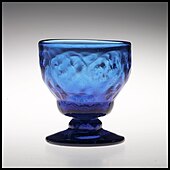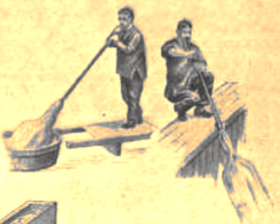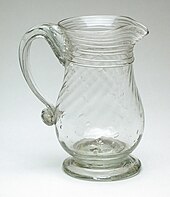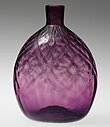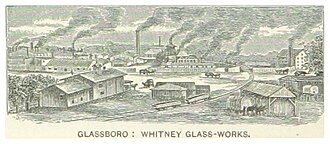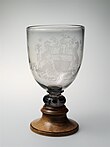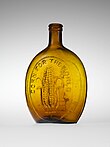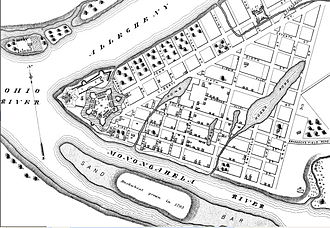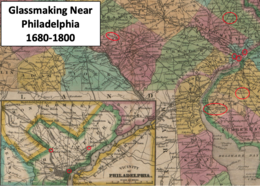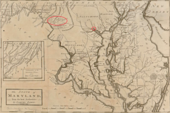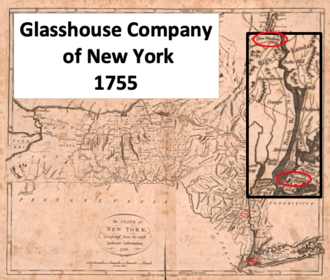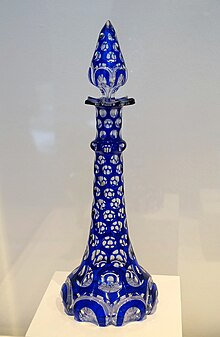
Venetian glass is glassware made in Venice, typically on the island of Murano near the city. Traditionally it is made with a soda–lime "metal" and is typically elaborately decorated, with various "hot" glass-forming techniques, as well as gilding, enamel, or engraving. Production has been concentrated on the Venetian island of Murano since the 13th century. Today Murano is known for its art glass, but it has a long history of innovations in glassmaking in addition to its artistic fame—and was Europe's major center for luxury glass from the High Middle Ages to the Italian Renaissance. During the 15th century, Murano glassmakers created cristallo—which was almost transparent and considered the finest glass in the world. Murano glassmakers also developed a white-colored glass that looked like porcelain. They later became Europe's finest makers of mirrors.
The Fostoria Glass Company was a manufacturer of pressed, blown and hand-molded glassware and tableware. It began operations in Fostoria, Ohio, on December 15, 1887, on land donated by the townspeople. The new company was formed by men from West Virginia who were experienced in the glassmaking business. They started their company in northwest Ohio to take advantage of newly discovered natural gas that was an ideal fuel for glassmaking. Numerous other businesses were also started in the area, and collectively they depleted the natural gas supply. Fuel shortages caused the company to move to Moundsville, West Virginia, in 1891.
Early American molded glass refers to glass functional and decorative objects, such as bottles and dishware, that were manufactured in the United States in the 19th century. The objects were produced by blowing molten glass into a mold, thereby causing the glass to assume the shape and pattern design of the mold. When a plunger rather than blowing is used, as became usual later, the glass is technically called pressed glass. Common blown molded tableware items bearing designs include salt dishes, sugar bowls, creamers, celery stands, decanters, and drinking glasses.
Novelty Glass Company of Fostoria was one of over 70 glass manufacturing companies that operated in northwest Ohio during the region's brief Gas Boom in the late 19th century. The company made bar goods, stemware, and novelties. Organization of the firm began late in 1890, with banker Rawson Crocker as president and veteran glass man Henry Crimmel as plant manager. Production started in February 1891. The plant was built on the site of the former Buttler Art Glass Company, which had been destroyed by fire in 1889.

Hartford City Glass Company was among the top three window glass manufacturers in the United States between 1890 and 1899, and continued to be one of the nation's largest after its acquisition. It was also the country's largest manufacturer of chipped glass, with capacity double that of its nearest competitor. The company's works was the first of eight glass plants that existed in Hartford City, Indiana during the Indiana Gas Boom. It became the city's largest manufacturer and employer, peaking with 600 employees.
Seneca Glass Company was a glass manufacturer that began in Fostoria, Ohio, in 1891. At one time it was the largest manufacturer of blown tumblers in the United States. The company was also known for its high-quality lead (crystal) stemware, which was hand-made for nearly a century. Customers included Eleanor Roosevelt and Lyndon B. Johnson, and retailers such as Marshall Field and Company, Neiman Marcus, and Tiffany's.
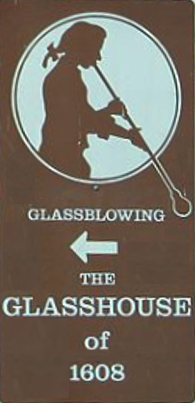
Early glassmaking in the United States began in Colonial America in 1608 at the Colony of Virginia near Jamestown, believed to be the first industrial facility in what would later become the United States. For centuries, glassmaking procedures, techniques, and recipes were kept secret, with countries actively preventing glassmaking knowledge from spreading beyond their borders. German workers with glassmaking knowledge, described as Dutchmen, along with Polish glass workers, were brought to Colonial America to begin operations. Although glass was made at Jamestown, production was soon suspended because of strife in the colony. A second attempt at Jamestown also failed.
J. H. Hobbs, Brockunier and Company was one of the largest and best-known manufacturers of glass in the United States during the 19th century. Its products were distributed worldwide. The company is responsible for one of the greatest innovations in American glassmaking—an improved formula for lime glass that enabled American glass manufacturers to produce high-quality glass at a lower cost. The firm also developed talented glassmakers that started glass factories in Ohio and Indiana.

John Frederick Amelung was a German-American glass artist active in Maryland.

The New Geneva Glass Works was an early American glass factory established in western Pennsylvania, active from 1797 until 1847.
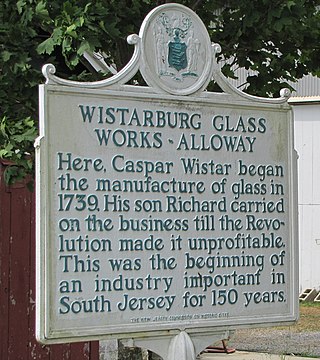
The Wistarburg Glass Works was the first successful glass factory and joint-venture enterprise in the Thirteen Colonies. Caspar Wistar founded the glass works company in 1739. He began by recruiting experienced glass artisans from Europe, and built homes for the workers along with a mansion for the factory's foreman. Wistar also had a company store built near the factory.
The Nickel Plate Glass Company was a manufacturer of tableware, lamps, and bar goods. It began operations in Fostoria, Ohio, on August 8, 1888, on land donated by the townspeople. The new company was formed by men from West Virginia who were experienced in the glassmaking business, and their company was incorporated in that state in February of the same year. They were lured to northwest Ohio to take advantage of newly discovered natural gas that was an ideal low-cost fuel for glassmaking. The company name came from the New York, Chicago and St. Louis Railroad, commonly known as the "Nickel Plate Road", which had tracks adjacent to the new glass plant.
The Fostoria Shade and Lamp Company was the largest manufacturer of glass lamps in the United States during the early 1890s. It began operations in Fostoria, Ohio, on May 17, 1890. The plant was run by Nicholas Kopp Jr., a former chemist at Hobbs, Brockunier and Company in West Virginia. Kopp achieved fame for his many glass designs and formulas for various colors of glass, and he is the discoverer of the American formula for selenium-based ruby glass. The company's products were very popular, and it was able to make significant profits early in its existence. In addition to lamps and shades for home lighting, the company also made novelties such as salt shakers.
Mambourg Glass Company was a window glass manufacturer that began production on October 26, 1887. The company was the first of thirteen glass manufacturers located in Fostoria, Ohio, in the United States, during northwest Ohio's gas boom. The plant was managed by Leopold Mambourg, a Belgian immigrant and experienced glassmaker. Much of the company's work force was also from Belgium. Former Ohio governor Charles Foster was president of the company and a major financial backer. He was also a major investor in other businesses and two additional Fostoria window glass companies: the Calcine Glass Company and the Crocker Glass Company. Mambourg was the chief operating officer for all three of Foster's window glass companies.
The Bellaire Goblet Company was the largest manufacturer of goblets in the United States during the 1880s. Its original glass plant was located in Bellaire, Ohio, which earned the nickname "Glass City" because of its many glass factories. Bellaire Goblet Company was part of Ohio's "Glass City" on the east side of the state, and later moved to the other side of the state to participate in Northwest Ohio's "Gas Boom". It also became part of a large glass trust.

Very few 19th Century glassmaking innovations in the United States happened at the beginning of the century. Only ten glass manufacturers are thought to have been operating in 1800. High-quality glassware was imported from England, and glassmaking knowledge was kept secret. England controlled a key ingredient for producing high–quality glassware and kept its price high—making it difficult for American glass manufacturers to compete price-wise. European glassmakers with the knowledge to produce high–quality glassware were, in some cases, smuggled to the United States. Eventually the American glass industry grew, and the second half of the century saw numerous innovations.
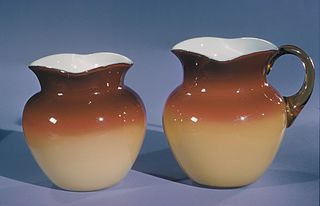
19th century glass categories in the United States include types of glass and decoration methods for glass. A simplified category version appropriate at the beginning of the century is glassware, bottles, and windows. As the century progressed, glass production became more complex and made necessary more categories and subcategories. An 1884 United States government report used glassware, bottles, windows, and plate glass as major categories—although plate glass accounted for only four percent of the value of all glass made.

19th century glassmaking in the United States started slowly with less than a dozen glass factories operating. Much of the nation's better quality glass was imported, and English glassmakers had a monopoly on major ingredients for high–quality glass such as good–quality sand and red lead. A tariff and the War of 1812 added to the difficulties of making crystal glass in America. After the war, English glassmakers began dumping low priced glassware in the United States, which caused some glass works to go out of business. A protective tariff and the ingenuity of Boston businessman Deming Jarves helped revive the domestic glass industry.
Bakewell, Pears and Company was Pittsburgh's best known glass manufacturer. The company was most famous for its lead crystal glass, which was often decorated by cutting or engraving. It also made window glass, bottles, and lamps. The company was one of the first American glass manufacturers to produce glass using mechanical pressing. In the 1820s and 1830s, Bakewell glassware was purchased for the White House by presidents James Monroe and Andrew Jackson. Founder Benjamin Bakewell is considered by some to be father of the crystal glassware business in the United States.

Sulphide portrait glassware is blown, cut, and molded glassware usually made from lead crystal that encases an image that appears silver or white as if made from silver sulphide. Although sulphide is used to describe glass decorated in this manor, the silver or white image is actually a clay paste. This glass decorating style was created in Europe during the late 18th century. In the United States, Pittsburgh glass manufacturer Bakewell, Page and Bakewell was the main manufacturer of sulphide portrait glassware in the United States during the 1820s. At that time, the ornamentation style was known as cameo–incrustation or crystallo ceramie. This type of glassware became popular again during the middle of the 19th century.
